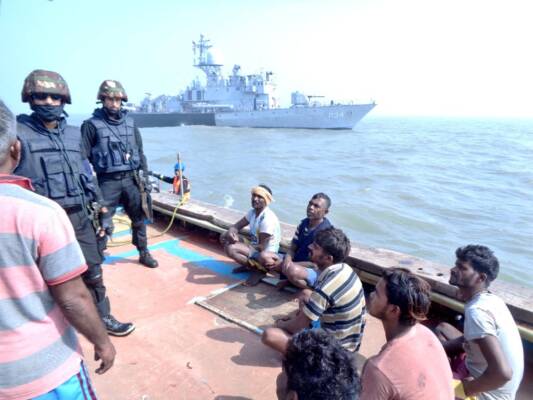
Sea Vigil is one the largest coastal security drill which is undertaken by India recently, successfully concluded on January 14. With the aim to test India’s preparedness to thwart any attempt by anti-national elements to carry out an attack on its territory or against its citizens by infiltrating through the sea route, Sea Vigil was first conducted in the year 2019 to ensure the internal maritime security and safeguarding country’s coastal areas.
The conceptual and geographical expanse of Sea Vigil included the entire coastline and Exclusive Economic Zone (EEZ) of the country, and contingencies from peace to war-time were exercised. After 26/11 Mumbai attack, the entire maritime security is one of the challenging and critical chronicles for the Indian Government and Defence Forces. In such a scenario, maritime drills being conducted from time to time by Indian Navy and all the stakeholders of maritime domain play significant role in combating the different types of sea terrorism and enhancing the security fences of the country.
The two-day Pan India coastal defence exercise was conducted on January 12 and 13 this year. The second edition of this biennial coastal security exercise was steered by the Navy in coordination with the Coast Guard, State governments, Union Territories and other maritime stakeholders. According to a defence press release, “The exercise was conducted in Kerala and Lakshadweep under the aegis of Commander-in-Chief, Coastal Defence, and saw the participation of more than 100 ships, patrol craft and aircraft of the Indian Navy and the Coast Guard, as well as patrol boats manned by various security agencies off the coast of Kerala, Mahe and Lakshadweep.”
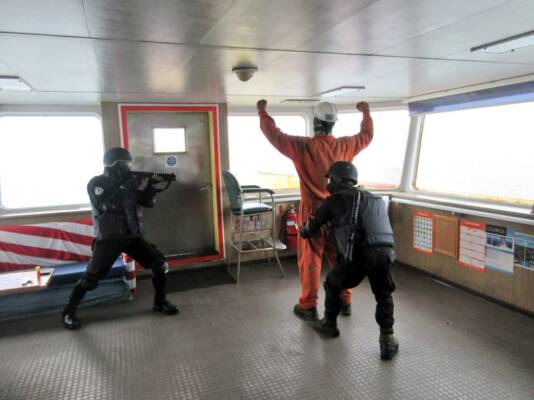
It involved the deployment of the entire coastal security apparatus and more than 110 surface assets of Indian Navy (IN) and Coast Guard (CG) participated in the exercise. In addition, mitigation measures on shore, in case of any breach in coastal security were also validated.
Sea Vigil which was undertaken in the the entire 7516 km coastline and Exclusive Economic Zone of India and clubbed together for the drill comprised of all the 13 coastal States and Union Territories along with other maritime stakeholders, including the fishing and coastal communities. The envisaged objectives of the exercise were met by the whole-hearted participation of all stakeholders. The cooperation and coordination among various agencies involved is a reassuring sign of progress made in the realm of Coastal defence and the exercise would go a long way in enhancing coastal defence and national security in the maritime domain. The entire coastline was kept under surveillance by the Indian Navy and Coastal Guard aircraft, and helicopters were also pressed into service to reinforce Special Operations personnel operating onboard offshore platforms.
As ports form the nerve centre of sea borne trade, security mechanism of ports was also validated during the exercise and the crisis management plans of all ports were assessed for their effectiveness to tackle emergencies. The State Police teams, Indian Navy Marine Commandos and Commandos from National Security Guard exercised to tackle acts of maritime terrorism. This exercise also validated the technical surveillance infrastructure called the National Command, Control, Communication and Intelligence (NC3I) Network. The Information Management and Analysis Centre (IMAC) at Gurugram and its various nodes across Indian Navy and Indian Coast Guards stations exercised for coordinating the surveillance and information dissemination mechanism.
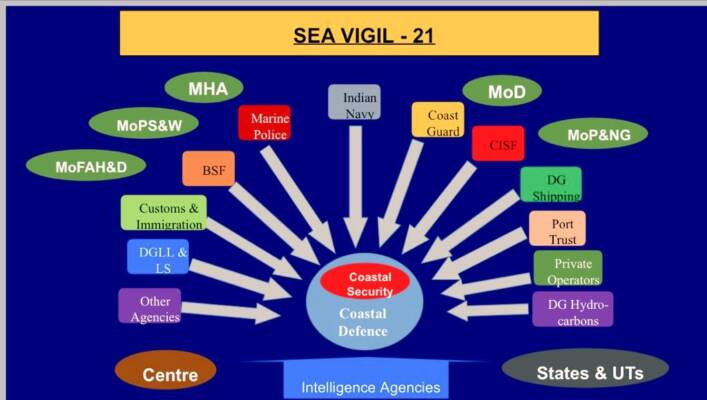
The press release stated: “The real-time picture of activities during the exercise was monitored by various operational and control centres, especially at the Joint Operation Centres in various States. Vice Admiral Anil Kumar Chawla, Flag Officer Commanding-in-Chief of the Southern Naval Command, who is also the Commander-in-Chief, Coastal Defence, Kerala, reviewed the progress of the exercise at Joint Operations Centre (Kochi) along with officials from various agencies.
“The lessons identified from the exercise would further strengthen the overall coastal defence structure of the country, especially in terms of seamless communication, coordination among security agencies and optimisation of resources,” the release noted.
Strengthening maritime mechanisms is one of the difficult areas for India and it is essential to focus on a realistic assessment of coastal security. Furthermore, coastal security is a vast phenomenon and therefore it is utmost important to build a solid maritime architecture to defend sea terror and combat various types of illegal sea activities. To put in the picture, India in the past few years has witnessed an enormous success in coastal security and experienced evolution in maritime domain. Henceforth this time Sea Vigil 21 was not only about maritime exercise but it was about the testing the sea infrastructure and critical maritime factors. The focus was on testing out the Inter agency coastal cooperation and the communication.
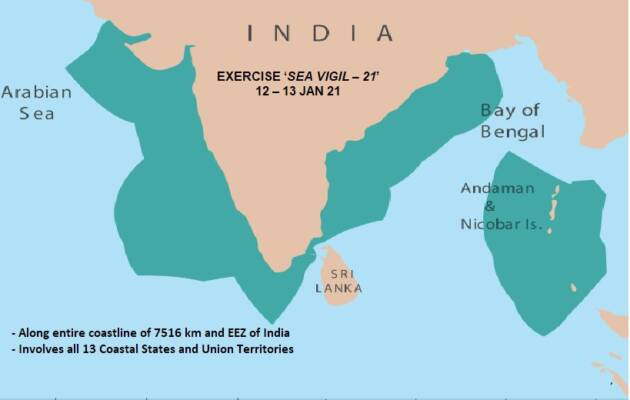
The entire coastal security set up was reorganised after the 26/11 Terror attack in Mumbai which was launched via sea route.
India has upgraded into three grid security infrastructures, including coastal radar, double the fleet of assets, Joint Operation centre, Information Management and Analysis Centre. Though India made significant progress in the coastal security, there were few areas where information was not flowing in the seamless manner. However, in the three areas mentioned above, these things have been corrected and now the fusion of information are disseminated and channelised from the states to tackle the situation. The role of Information Management and Analysis Centre in Gurugram played crucial role in defending the sea criminal activities.
Apparently, maritime defence exercise like this is a build up towards the major Theatre-level Readiness Operational Exercise (TROPEX) which Indian Navy conducts every two years. SEA VIGIL and TROPEX together cover the entire spectrum of maritime security challenges, including transition from peace to conflict. The major assets of the Indian Navy, Coast Guard, Customs and other maritime agencies participate in SEA VIGIL also co contributed and facilitated by the Ministries of Defence, Home Affairs, Shipping, Petroleum and Natural Gas, Fisheries, Customs, State Governments and other agencies of Centre/ State.
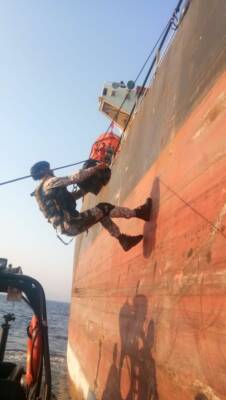
In nutshell, excellent coordination between Indian Navy and Indian Coast Guard has been playing key role in creating a holistic internal maritime security. Their incredible initiatives have set up a completely different picture towards national and overall maritime security. However, there are certain coastal areas where basic security equipment is not installed and hence identification of such vulnerable coastal areas must be captured. India also must look upon at the offshore security like combating drug tracking, arms robbery and various other sea criminal activities.
Exercise Sea Vigil is not only honing and toning up for better sea architecture but also has enhanced the intelligence zones by involving the local and fishing communities. The development of coastal leaders in vulnerable shores is an essential criterion for defending the challenges of international as well as internal security.
-The writer is a Meghalaya-based Defence Correspondent








